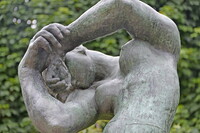| dc.coverage.spatial | Site: Musée Rodin (Paris, Île-de-France, France) | en_US |
| dc.coverage.temporal | cast after 1900 (creation) | en_US |
| dc.creator | Rodin, Auguste | en_US |
| dc.date | 1900-1910 | en_US |
| dc.date.accessioned | 2016-08-23T18:13:07Z | |
| dc.date.available | 2016-08-23T18:13:07Z | |
| dc.date.issued | 1900-1910 | en_US |
| dc.identifier | 267877 | en_US |
| dc.identifier.other | archrefid: 3340 | en_US |
| dc.identifier.uri | http://hdl.handle.net/1721.3/184191 | |
| dc.description | Detail, head, arms and upper torso; Constructed around a sinuous line, her contrapposto incomplete, Meditation originated in a figure on the tympanum of The Gates of Hell, inspired by Michelangelo. She was then reworked into the Monument to Victor Hugo (ca. 1896), before being enlarged under the name The Inner Voice. She represented one of the muses who inspired the poet. In order to include her in the monument, Rodin had to remove her arms and amputate part of her legs. This bronze is a further reworking and enlargment, adding the arms. The cast was done after 1900 and stands in the museum gardens. Source: Musée Rodin [website]; http://www.musee-rodin.fr/en/ (accessed 6/18/2015) | en_US |
| dc.format.medium | bronze | en_US |
| dc.rights | © Scott Gilchrist, Archivision, Inc. | en_US |
| dc.subject | human figure | en_US |
| dc.subject | Nineteenth century | en_US |
| dc.title | Meditation with Arms [adapted after 1900] | en_US |
| dc.title.alternative | The Inner Voice | en_US |
| dc.type | image | en_US |
| dc.rights.access | Licensed for educational and research use by the MIT community only | en_US |
| dc.identifier.vendorcode | 6A1-RA-WST-A06 | en_US |
| vra.culturalContext | French | en_US |
| vra.technique | modeling (forming), casting (process) | en_US |
| vra.worktype | sculpture (visual work) | en_US |
| dc.contributor.display | Auguste Rodin (French sculptor, 1840-1917) | en_US |

